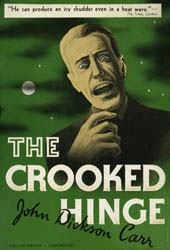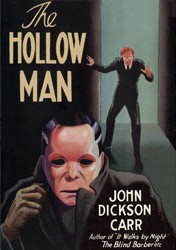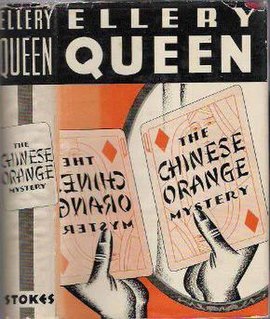Related Research Articles
John Dickson Carr was an American author of detective stories, who also published using the pseudonyms Carter Dickson, Carr Dickson, and Roger Fairbairn.
The "locked-room" or "impossible crime" mystery is a type of crime seen in crime and detective fiction. The crime in question, typically murder, is committed in circumstances under which it was seemingly impossible for the perpetrator to commit the crime or evade detection in the course of getting in and out of the crime scene. The crime in question typically involves a crime scene with no indication as to how the intruder could have entered or left; for example, a victim found deceased in a windowless room that is sealed from the inside at the time of discovery. Following other conventions of classic detective fiction, the reader is normally presented with the puzzle and all of the clues, and is encouraged to solve the mystery before the solution is revealed in a dramatic climax.

Mystery is a fiction genre where the nature of an event, usually a murder or other crime, remains mysterious until the end of the story. Often within a closed circle of suspects, each suspect is usually provided with a credible motive and a reasonable opportunity for committing the crime. The central character is often a detective, who eventually solves the mystery by logical deduction from facts presented to the reader. Some mystery books are non-fiction. Mystery fiction can be detective stories in which the emphasis is on the puzzle or suspense element and its logical solution such as a whodunit. Mystery fiction can be contrasted with hardboiled detective stories, which focus on action and gritty realism.

Death from a Top Hat (1938) is a locked-room mystery novel written by Clayton Rawson. It is the first of four mysteries featuring The Great Merlini, a stage magician and Rawson's favorite protagonist.

The Mystery of the Yellow Room is a mystery novel written by French author Gaston Leroux. One of the first locked-room mystery novels, it was first published serially in France in the periodical L'Illustration from September 1907 to November 1907, then in its own right in 1908.

Dr Gideon Fell is a fictional character created by John Dickson Carr. He is the protagonist of 23 mystery novels from 1933 through 1967, as well as a few short stories. Carr was an American who lived most of his adult life in England; Dr. Fell is an Englishman who lives in the London suburbs.
Edward Dentinger Hoch was an American writer of detective fiction. Although he wrote several novels, he was primarily known for his vast output of over 950 short stories.
Sir Henry Merrivale is a fictional amateur sleuth created by "Carter Dickson", a pen name of John Dickson Carr (1906–1977). Also known as "the Old Man," by his initials "H. M.", or "the Maestro", Merrivale appears in 22 of Carr's locked-room mysteries and "impossible crime" novels of the 1930s, 1940s, and 1950s, as well as in two short stories.

He Who Whispers is a mystery novel (1946) by detective novelist John Dickson Carr. Like Many of the works by this author feature so-called impossible crimes. In this case, the novel falls into a smaller category of Carr's work in that it is suggested that the crime is the work of a supernatural being. The detective is Dr. Gideon Fell, who ultimately uncovers a rational explanation for the novel's events. Carr considered this one of his best impossible crime novels.

The Crooked Hinge is a mystery novel (1938) by detective novelist John Dickson Carr. It combines a seemingly impossible throat-slashing with elements of witchcraft, an automaton modelled on Maelzel's Chess Player, and the story of the Tichborne Claimant. It was dedicated to fellow author Dorothy Sayers "in friendship and esteem".

Rim of the Pit (1944) is a locked-room mystery novel written by Hake Talbot, a pen name of Henning Nelms. Nelms, as Talbot, published one other mystery novel as well as two short stories.

The Hollow Man is a 1935 locked room mystery novel by the American writer John Dickson Carr, featuring his recurring investigator Gideon Fell. It contains in chapter 17 the often-reprinted "locked room lecture" in which Dr Fell speaks directly to the reader, setting out the various ways in which murder can be committed in an apparently locked room or otherwise impossible situation.
Thomas W. Hanshew was an American actor and author, born in Brooklyn, N. Y.

The Emperor's Snuff-Box is a non-series mystery novel (1942) by mystery novelist John Dickson Carr. The detective is psychologist Dr. Dermot Kinross.

The Chinese Orange Mystery is a novel that was written in 1934 by Ellery Queen. It is the eighth of the Ellery Queen mysteries.
Joseph Commings was an American writer of locked room mysteries. He wrote a series of soft-core sex novels, but is best known for his locked-room mystery/impossible crime short stories featuring Senator Brooks U. Banner."

The Plague Court Murders is a mystery novel by the American writer John Dickson Carr, who wrote it under the name of Carter Dickson. The first Sir Henry Merrivale mystery, it is a locked room mystery of the subtype known as an "impossible crime".

The Curse of the Bronze Lamp is a mystery novel by the American writer John Dickson Carr, who published it under the name of Carter Dickson. It is a locked room mystery or, more properly, a subset of that category known as an "impossible crime", and features the series detective Sir Henry Merrivale. Carr considered this one of his best impossible crime novels.

The Black Spectacles, first published in 1939, is a detective story by John Dickson Carr featuring his series detective Gideon Fell. This novel is a mystery of the type known as a locked room mystery.

Till Death Do Us Part, first published in 1944, is a detective story by John Dickson Carr featuring his series detective Gideon Fell. This novel is a mystery of the type known as a locked room mystery. Carr considered this one of his best impossible crime novels.
References
- ↑ "Mike Grost on Hake Talbot". pbworks.
- ↑ "A Handbook for Conjurers". Retrieved 2 June 2016.
- ↑ "Ranking of Impossible Crimes by Experts". MysteryFile.com.